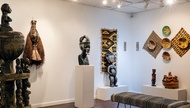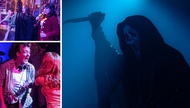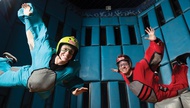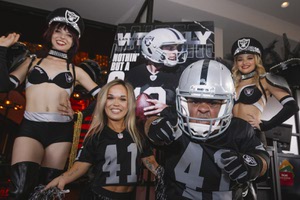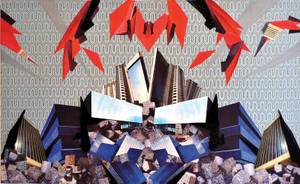When you have a spectacle so outlandish, ridiculous, technologically advanced and unimaginable, people are naturally going to talk.
Feed the spectacle with money (lots of money), wild ideas, gimmicks, millions of gallons of alcohol and uncompromising demands on the environment; build castles to outdo the castles that outdid the previous castles, and suddenly you have a social study.
Las Vegas is nothing like anywhere else and everything like everywhere else. It’s the great microcosm, the head-scratching experimental wonder of the world, and those of us who live here are gifted (or cursed) with front-row seats.
Discussions abound of unhinged capitalism, human arrogance, superficiality and philistinism. Artists, too, explore these concepts. How they respond to this environment recently caught the attention of Chad Alligood, assistant curator of the Crystal Bridges Museum of American Art in Arkansas, who along with museum president Don Bacigalupi, has been traveling the country, considering artists from each state for the museum’s upcoming State of the Art exhibit, which looks at contemporary American culture through works by 100 artists from across the U.S.
Las Vegas, Alligood told the Huffington Post, “more than any other place, seemed to me to be really responsive to the local context.
“Las Vegas has such a rich visual and metaphorical terrain that artists can’t help, but respond,” he added. “So, they’re making things that are obsessed with surface, that are interested in the multiplication and duplication of imagery, that are interested in ideas of excess and ornament and decoration: impermanence, dynamic change.”
It’s a comment that brings to mind Laurenn McCubbin’s performance art on Las Vegas Boulevard, where she and her team passed out artist-designed sex worker cards to address the economic impact of sex work in a city that markets it but regulates against it. Or the replication in cardboard of CityCenter’s $40 million art collection by artist Justin Favela, or Anthony Bondi’s collages that piece together imagery of Las Vegas with other places (the real Venice, for example) and historical eras to create the collaged incongruity that lives as one on the Strip and in its psyche.
Jennifer Kleven has likened her photography series of cellphone towers wearing “nature outfits” that present them as pine trees with that of the faux elsewhere of the Strip’s casinos.
Then there is Stephen Hendee’s angular steel mountain with future-past overtones that was placed atop a time capsule in Centennial Plaza to be opened in 2105.
Commissioned by the City of Las Vegas for its 100th anniversary, “Monument to the Simulacrum” (which is 12 feet high and 9 feet in diameter) represents the idea that Las Vegas beat the odds, that somehow this rest stop in the Mojave Desert became a city on steroids built by dreamers in an area of limited resources—an unchecked fantasyland.
Hendee topped it all off by dedicating the sculpture to late French philosopher Jean Baudrillard, known for his treatise on simulacra.
While not every artist here explores the idea of Las Vegas (more don’t than do), those who do rarely take the same approach, even if they share similar philosophies.
We spoke with artists Erin Stellmon, Justin Favela, Mark Brandvik and David Sanchez Burr about Las Vegas and how their work relates to the spectacle, the community surrounding it and the desert that serves as a constant backdrop.
-
Justin Favela
The Material Is the Message
Justin Favela was born and raised in Las Vegas, growing up in government housing amid a tight-knit family of Mexican and Guatemalan heritage. Favela was a childhood fan of Mr. Rogers’ Neighborhood, and TV and popular culture live large in his interests, showing up in Favela’s often-humorous piñatas and other cardboard constructions.
One of his early works was “Las Vegas, Las Vegas”—a photograph of a crudely constructed and charmingly sentimental assembled neighborhood that Favela built out of paper and cardboard, painted and then photographed at a low angle, placing the visitor in the neighborhood with a child’s-eye view of the buildings and streets.
The piece, made in 2009 for a nationally themed postcard exhibit, was Favela’s way of documenting the architecture and memory of his own history in Las Vegas, brought on by the realization that buildings he knew were beginning to disappear. It features UNLV’s Grant Hall, Champagnes Cafe, the houses he’d lived in, his grandmother’s home and the casinos where his family worked. At one end is the Welcome to Fabulous Las Vegas sign, connecting the tourist town with his personal community.
That the finished piece was a photograph and not the sculpture is characteristic of Las Vegas, where much of the area’s past is visible only in postcards, archived images and the signs in the Neon Museum, where Favela once worked.
Las Vegas and its community returned again as themes for his 2011 installation at the Clark County Government Center, where he appropriated works in CityCenter’s $40 million art collection. The humorous exhibit with mocking undertones was a way for the artist to bring the collection, often called “public art,” off the Strip and into the community. It included a Las Vegas bent on Maya Lin’s “Silver River” (hanging behind the Aria front desk), exchanging Lin’s rendering of the Colorado River in silver for a rendering of the Las Vegas wash made out of chicken wire and aluminum foil.
That Favela’s works are made from cardboard and papier-mâché is characteristic of the ephemeral nature of Las Vegas and the materials used to construct it, while adding a “weird juxtaposition” to the sleek and shiny. “Estardus,” a large cardboard and glue sculpture resembling the Stardust sign’s Atomic Age design and vintage color palette, might seem durable from afar, but its cardboard construction mirrors the more impermanent materials—namely fiberglass and Styrofoam—of pillars, statues and other casino ornamentation.
“Part of my process in art making is problem solving with limited resources,” he says. “I can make something about nothing with cheap materials. And that’s Las Vegas. It grew from a pit stop to this with limited resources.”
Favela, who received a BFA from UNLV, says that he thinks about going to graduate school in another city, an idea he says is somewhat frustrating because it would take him away from these stimuli.
“It’s so easy to be inspired here.”
-
David Sanchez Burr
The Larger Picture
Sound and video artist David Sanchez Burr grew up in Spain, living in the suburbs of Madrid surrounded by fields and orchards. When he returned 15 years after moving away, the landscape he remembered no longer existed—it had all been developed.
Urban encroachment on the environment (and its effects) is a story that exists nearly everywhere, but in Las Vegas, it seems to happen at hyper speed. Add to that the extreme juxtaposition of the desert against the development and you have an intensely visible example.
“It’s not as clear in other cities because of topography,” Sanchez Burr says. “Here, the desert climate and strange circumstances create a stark contrast.”
For him, the Las Vegas area and its surroundings flag other global, social and psychological issues, representing growth and decay, urban and human impact on the natural world, economy and the democratic process.
His installations, sculptures and video works focus on the pace and occurrence of change, emphasizing the constant state of flux through artwork that is evolving, rather than static on the wall.
In advocating democracy in city building, the artist had visitors to Cosmopolitan’s P3Studio create their own city sculptures that were destroyed by sound vibrations—a revolving cycle of urban renewal and decay. The lighting, materials and ideology screamed Las Vegas, but the idea extended beyond the Valley, demonstrating the role of a community in a city’s development, as opposed to technocrats, who build in their image and have the power and wealth to make all the decisions.
The abandonment and dumping of objects in outlying areas here (the “Kuiper Belt” of Las Vegas) led Sanchez Burr to study decay of foreign elements in the desert. The open landscape became his studio; the art was the natural manipulation of the unnatural.
“This city had a big impact on my artwork,” says the artist, who came to Las Vegas for UNLV’s MFA program. “As an artist practicing in ephemeral motion-based, time-based art, it opened my eyes a lot. It made it easier to flag my interests. There are brighter contrasts here that I drew from.”
He approaches art as a change agent and suggests that Las Vegas is a composite of the world that can offer solutions. It’s not, he says, a city that lives in a bubble.
“The concept of Las Vegas is owned by the people who visit here and live outside of Las Vegas. They’re the ones who shape it. The weight of all these people visiting is manifested through the desert because of this economic potential.”
-
Erin Stellmon
Neon and Transformation
It seems inevitable that artist Erin Stellmon would land in Las Vegas.
A graduate of Parsons who grew up in Portland, Oregon, Stellmon had been obsessed with neon since childhood and with Vegas since her teens. Steeped in nostalgia, she documented the disappearance of neon in Portland for her BFA, then spent two years selling paintings of Portland-style neon in New York City and living as a very traditional representational painter.
All of that changed, however, when she came to Las Vegas for UNLV’s MFA program. The idea of painting the haunting, moody glow of neon against Portland’s daytime gray skies no longer applied in the world of Las Vegas neon. Nor did continuing to explore nostalgic themes of home, fairs, Coney Island and Americana.
“Las Vegas turned all of that around,” says Stellmon, who works at the Neon Museum. “There’s something about Las Vegas that has a pioneer feel. The evolution of this city is so prevalent that it influences everything.”
Soon she was reconfiguring neon of the past in futuristic mixed-media works. In her Reign of Glass exhibit, Stellmon’s compositions commented on CityCenter as a planned city and community on Las Vegas Boulevard, while exploring the construction boom and ever-transforming nature of Las Vegas. Made with craft materials (Stellmon built a futuristic city out of Shrinky Dinks), she placed CityCenter and the idea of transformation within a timeline of hotel-casinos that preceded it. In one piece, a CityCenter structure was being demolished before workers finished building it.
In Reinventing the West, Stellmon revisited the pioneer spirit and ideas of community, this time through Downtown redevelopment, where the past and present clashed in charged works made from patterned fabric, paper, glitter and plastic, creating futuristic landscapes of urban Las Vegas.
For her, the constant change of Las Vegas and locals’ hyper-awareness of their surroundings is inviting compared to living in the traditions, history and rules of New York City.
“This town adjusts so quickly to change,” she says. “There are always people trying something new. There’s always someone coming in and mixing stuff up every few years. It encourages constant commentary.
“Every generation in Las Vegas has seen a completely different world than the previous one.”
-
Mark Brandvik
Image Is a Tool
When artist Mark Brandvik built a large-scale, Vegas-themed jungle gym in the Clark County Government Center in early 2012 and titled it Green Felt Jungle Gym after the 1963 book by Ed Reid and Ovid Demaris, it seemed he was once again tapping into the marvel that is the native Las Vegan’s backyard.
Constructed out of fencing material, the installation resembled a large playground in the shape of the Las Vegas skyline, complete with swings and trapeze rings. The bars served as a “contour line drawing in space” of the Stratosphere, the Luxor and the Wynn. For viewers, it fell directly into the idea of Las Vegas as an adult playground.
More than that of maybe any other artist, Brandvik’s work seems easy to link to the idea of Las Vegas. His flat minimalist paintings of Vegas architecture and local places capture the austere natural landscape and depict the town as empty and isolated as it can appear during the sweltering summers when everyone seeks shelter indoors. His paintings conjure the emotionally desolate nature of a city often regarded as lonely.
But the works by Brandvik, who received his BFA from UNLV and master’s from University of North Carolina at Chapel Hill, are not so much about Las Vegas as they are about form, color and composition. The architecture is often altered and the building removed from its location and placed against another background, making it more ambiguous than specific.
“It just so happened that I lived in Las Vegas,” he says. “It didn’t necessarily have to be Las Vegas. I just responded to the place I was in.
“A lot of it is tied to a memory of a place or how we like to reconstruct our world, or maybe our world is constructed of memories.”
Much of his work, he says, begins with a Vegas theme or image that becomes unrecognizable to anyone outside the Valley. In Green Felt Jungle Gym, he says, the Stratosphere could be a rocket; the Wynn could be a Richard Serra.
Sometimes there’s humor in his work, as in his depiction of the Morton Salt Girl as “Lot’s Wife” and the Sun-Maid raisin girl as Mother Mary holding wine grapes in “Pieta.” Religious references are recurring.
His series on death in Las Vegas, however, links murder, suicide and death by natural causes to the idea that Vegas has been a final destination for some. The series includes reductive paintings that highlight the street corner where Tupac Shakur was killed, the house where Ted Binion died of an overdose and the street where jazz singer Joe Williams collapsed and died on the way home from the hospital. In this series, he says, Las Vegas is secondary, not vital.
But, he adds, “Being out here, there’s something about the vastness and the way the horizon gets lost.”

